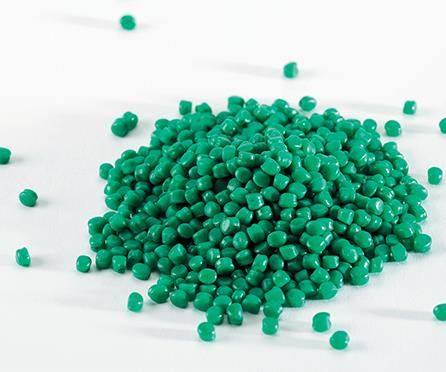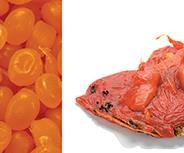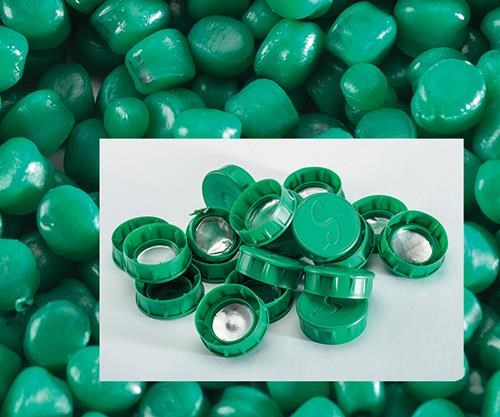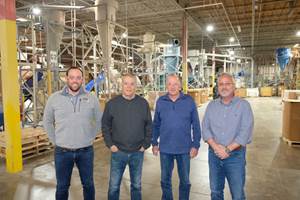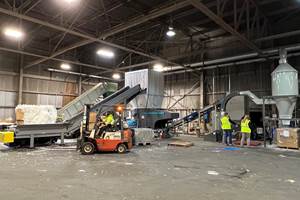Are You Getting Maximum Value From Your Plastic Scrap?
If not, you’re throwing away money. The solution comes from knowing the difference between a scrap materials reprocessor and a recycler, and how to evaluate what a reprocessor can do for you.
All plastics processors generate scrap as a part of their operations. The question is, are they getting the maximum value for their plastic scrap? In some rare cases, processors generate clean scrap that can be re-introduced into their process without additional, outside treatment.
But what if, like most processors, you generate scrap that cannot be utilized “as is” due to part size, metal content, or cross-contamination with other polymers? Fortunately, there are reprocessing options that can help you solve your scrap issues and improve your bottom line at the same time. You have the same raw-material cost in the scrap you generate as you do in the finished product you produce, so why sell your scrap for pennies on the dollar? Plastics manufacturers that aim to maximize the value of their post-industrial plastic scrap must align their strategies with a reprocessor, not just a recycler—there is a huge distinction.
ROLE AND LIMITATIONS OF THE RECYCLER
Recyclers, as a group, represent a narrow range of capabilities. Most, due to limited equipment, technology, and expertise, are restricted to acquiring plastic scrap as cheaply as possible to resell or export into alternative markets. Most do nothing more than sort, grind, or bale for resale. This results in fairly limited value for the generating processor other than convenience and immediate sales dollars.
There are also numerous reasons plastics processors refrain from utilizing recyclers to recover usable plastics. One of the main obstacles is the inability to get their customers to allow use of recycled material back into a given part, or the processor’s unwillingness to risk putting recycled material into the part. These concerns are not without merit and the foundation for skepticism boils down to several reasons:
• Traceability and the inability to prove materials have not been mixed with others.
• Negative experiences concerning purity and quality of recycled materials.
• Lack of trust that material will be reprocessed correctly and consistently.
• Perception that the scrap cannot be reprocessed due to contaminants in the material.
• Concern that using reprocessed material can cause downtime
in production.
• Concern that reprocessed materials could damage or plug runners,nozzle tips, gates, and mold cavities.
• Concern that parts containing recycled material might fail to meet quality expectations.
• Fear that recycled plastic, when mixed with virgin material, generates an inferior polymer.
Fortunately, technology exists to recover even some of the most contaminated plastics to a level where all these issues can be addressed by choosing the right partner. This is where a reprocessor—as opposed to a recycler or scrap broker—adds a considerable amount of value.
Many companies have managed to do more than meet a “no-landfill” mandate; they have instead found a way to consume material that they once had to sell off by implementing a plastic scrap-recovery strategy with a reprocessor. Reprocessors won’t just make your post-industrial scrap issues go away; they can turn those issues into opportunities for manufacturers to reuse scrap in their processes and save a considerable amount of money, even in times when the market is experiencing challenging economics, such as today. Consider the value added as detailed in the following case study:
Problem: One of the world’s leading molders of PP caps and closures was generating scrap at its manufacturing facilities. This material was generated as whole closures or could be ground for destruction and freight savings at their facility. In both cases, the material was not suitable for manufacturing new caps and closures because of the paper and foil liners. The molder did not want to grind the scrap closures itself and introduce foil and paper into its system. The firm tried using a conventional recycler to pelletize the material. Both the original recycler and OEM tried using metal detectors to remove any pellet that contained foil, but this was found to be unreliable and the residual foil in the pellets frequently plugged mold gates and set off metal detectors constantly. Moreover, the paper left in the regrind created a burnt smell in the plastic material. The processor believed that foil- and paper-lined closures could not be recycled. Then there was the issue of inconsistent MFI, which also was the cause for poor molding performance.
Solution: A plastic reprocessing company worked with the closure manufacturer to develop a recovery solution. The manufacturer sent the reprocessor a pilot production run to prove reprocessability of the foil/paper-lined closures. The reprocessor used proprietary techniques to remove the foil and paper from the polyolefin material and produced 99.99% pure pellets. It also was able to maintain traceability, color, and MFI of the plastic and in some cases to improve the MFI. The reprocessed resin was subjected to both durability and aesthetic testing. It was approved by the manufacturer’s lab with zero production problems recorded.
Benefit to Customer: The closure manufacturer was able to reclaim the PP from the foil/paper-lined closures and reduce material costs over 30% by reducing the amount of prime resin used and eliminating much of the firm’s material waste with the introduction of reprocessed material.
WHAT TO LOOK FOR IN A REPROCESSOR
First, change expectations with respect to the relationship you are trying to forge with a reprocessor. Think of it as your industrial partner rather than a scrap outlet. When you change your thinking, you change the way you evaluate such a potential partner. Is it a recognized name in the industry? Is it held in high regard by customers that have utilized its services? Reputation can be a huge indicator of the ability to perform when you need it. A reputable reprocessor should be willing to give references.
Some other questions to consider: Does the reprocessor have a reputation for being innovative? How often does it reinvest in the company and its capabilities?
A reprocessor that has committed to becoming a true partner is looking to build a lasting relationship. It is also committed to continuous improvement in quality and the cost of processing, both short- and long-term.
Whether you have issues with silo cross-contamination, produce whole parts and assemblies with metal and polymer contaminants, or have cross-contaminated regrind, purgings, floor sweepings, or other complex feed streams, a reputable reprocessor can turn your scrap plastic into usable raw material on a consistent basis and at a cost saving relative to prime resins.
Let’s explore the gains a pharmaceutical bottle manufacturer made by using a reputable reprocessor:
Problem: A pharmaceutical bottle manufacturer generates amber purge, strands, and die drool. The material is burnt and discolored from sitting in the barrel and it has adhered to cardboard. The plant had a recycler pelletize the material, but it was all rejected due to carbon black specks; the application was appearance-critical.
Solution: In contrast to a typical recycler that simply melt-filters the regrind, a reprocessing company began by requesting samples prior to producing material. After testing the samples of the purge, strands, die drool, and other plastic scrap, the reprocessor approached the bottle maker with a comprehensive recovery solution and a guaranteed outcome prior to any processing taking place. Unlike a typical recycler, the reprocessor was able to handle all the various materials and returned a 99.99% pure amber pellet that was successfully introduced back into the manufacturer’s production at a 25% ratio.
Benefit to Customer: The bottle manufacturer realized a 35% net savings in material costs and gained enough confidence that it continued to work with the reprocessor on other projects to grow the firm’s plastic recovery program.
YEARS OF PROVEN EXPERIENCE
There is no substitute for proven experience. Leverage your reprocessor’s hard-won know-how. It’s no secret that experienced labor and practical knowledge is very hard to come by in the plastics industry. A reprocessor that has been in this industry for a long time will almost certainly have a staff with decades of experience in plastics reprocessing. These people should understand your industry, materials, processing demands, and purity expectations. They can be a trusted asset. Leverage that asset.
STATE-OF-THE-ART TECHNOLOGY
Status quo is never an option. Your reprocessor should consistently be looking at new technologies and incorporate new intellectual strategies that result in better results for its customers. Being innovative means looking past the equipment, and considering better ways to use the equipment and strategies that increase efficiencies and results for the customer.
To achieve the best results in reprocessing materials, it is important to have state-of-the-art equipment. There have been huge changes in what that equipment can produce in the way of quality for a final product. While most reprocessors treat their equipment and processes as trade secrets, a discussion about how often they invest in their equipment might be worth having.
Not only does a reprocessor need the correct equipment, it needs the processing knowledge of how to use it to deliver the best results. Look for a reprocessor that has multiple processes under one roof. This will translate into a greater number of solutions for you. Freight can be a big factor in overall cost. If your reprocessor has the solution in-house, this means less freight from shipping to subcontractors, which translates into reduced costs.
And do not rule out a visit to the reprocessor’s facility. The condition of that plant, along with how the firm presents itself, will tell you a great deal about the operation and the risk/reward involved in working with that firm. At a minimum, it should be committed to keeping its facility neat, clean, and orderly. This translates into a substantial reduction in risk of cross-contamination of materials—your materials. Your reprocessor should simply be committed to exceeding your expectations and be committed to continuously finding ways to do better, deliver more, faster, at better prices without any compromise in the quality of the service it is being asked to provide.
Customer service is an area where many companies fail. This is the one area where your reprocessor should work to exceed your expectations. Customer service includes being available when you need answers, understanding and working toward mutual goals, providing transparency in lot traceability, working to make difficult tasks easy.
When your reprocessor makes a commitment to reach a certain purity and yield, you need to have the confidence that it will be done. Ask the reprocessor to guarantee the outcome.
ABOUT THE AUTHOR: JOHNSON
Bryan Johnson is dir. sales and marketing for Butler-MacDonald Inc., Indianapolis, Ind., a company that converts plastic scrap, contaminated plastics, and hard-to-recycle assemblies into materials that customers can substitute for prime resin or sell for higher-market value. Contact: (317) 872-5115; bjohnson@butlermacdonald.com; butlermacdonald.com.
Related Content
Evolving Opportunities for Ambitious Plastics Recycler
St. Joseph Plastics grew from a simple grinding operation and now pursues growing markets in recycled PP, food-grade recycled materials, and customized post-industrial and post-consumer compounds.
Read MorePurpose-Built System Enhances Capacity and Flexibility for Recycler
A Boston recycler invested in a turnkey shredding, granulation and elutriation system to expand its plastics reclaim business.
Read MoreExtrusion Technology Extended to Injection, Enabling Up to 100% Regrind Usage
Twin-barrel (shot-pot) press can handle more regrind, offers other benefits to molders.
Read MoreInside the Florida Recycler Taking on NPE’s 100% Scrap Reuse Goal
Hundreds of tons of demonstration products will be created this week. Commercial Plastics Recycling is striving to recycle ALL of it.
Read MoreRead Next
See Recyclers Close the Loop on Trade Show Production Scrap at NPE2024
A collaboration between show organizer PLASTICS, recycler CPR and size reduction experts WEIMA and Conair recovered and recycled all production scrap at NPE2024.
Read MoreBeyond Prototypes: 8 Ways the Plastics Industry Is Using 3D Printing
Plastics processors are finding applications for 3D printing around the plant and across the supply chain. Here are 8 examples to look for at NPE2024.
Read MorePeople 4.0 – How to Get Buy-In from Your Staff for Industry 4.0 Systems
Implementing a production monitoring system as the foundation of a ‘smart factory’ is about integrating people with new technology as much as it is about integrating machines and computers. Here are tips from a company that has gone through the process.
Read More
